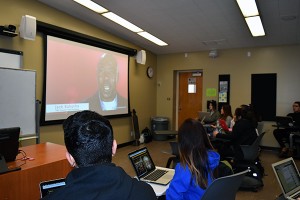
Students in Laura Guardino’s U.S. History and Government (HIST 15A) course watch a short video in a ‘smart classroom’ in Sweeney Hall.
In the College of Social Sciences, three history faculty members received CSU Proven Course Redesign grants to update U.S. History and Government (HIST 15A) courses. The professors are using some flipped classroom techniques in the general education course.
Laura Guardino said the course used to be team taught as it incorporated history and political science concepts. Since the department was already planning to redesign the course to focus only on history topics, she and two of her colleagues decided to apply for the Proven Course Redesign grant to support the effort.
Guardino said the goal of the redesign is to ensure they teach students the skills they will need in upper division courses such as critical thinking, analytic skills, close reading analysis, how to cite sources, write a thesis and make oral presentations. The other faculty members with grants include Robert Cirivilleri and Katherine Chilton.
“We are using an online learning platform that students can use on their smart phones or laptops,” Guardino said. “It makes grading more efficient. Students can read essays and view lectures online. Discussions in class extend into concrete problem debates.”
The history professors are using an online platform, Globalyceum, that was created by retired SJSU Professor Pat Don, who taught Social Science Teacher Education and wanted to create a curricular resource that maximizes technology.
Guardino added that the trio received funding for iPads for the classes and would begin incorporating the tablets into their instruction in mid-March. She said Academic Technology staff members have been supportive in helping her and her colleagues learn how to use the resources in their Smart Classrooms that are equipped for audio-visual presentations.
On a recent morning, students in Guardino’s smart classroom watched a video about modern-day slavery before delving into a discussion on slavery before the Civil War.
“We want to find a little connection to the present day,” she said. “We ask a probing question that is connected to their lives.”